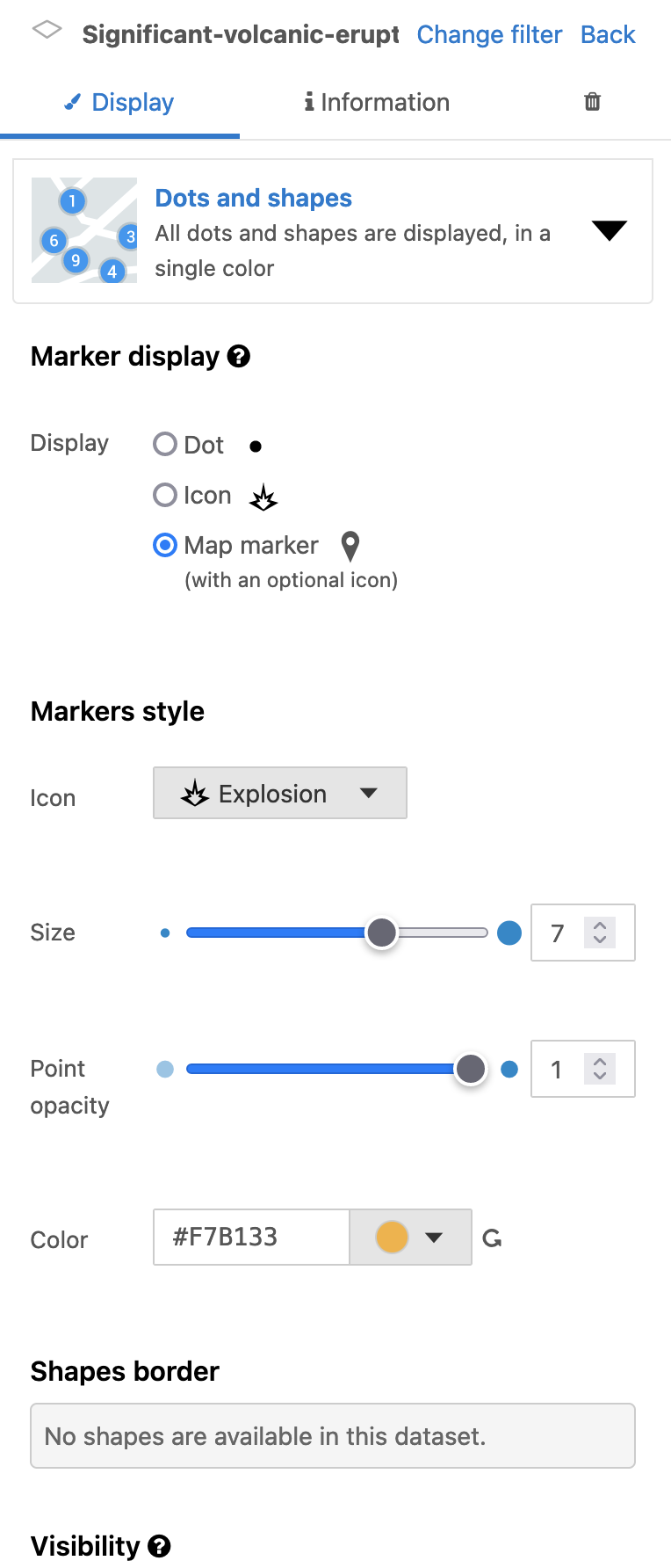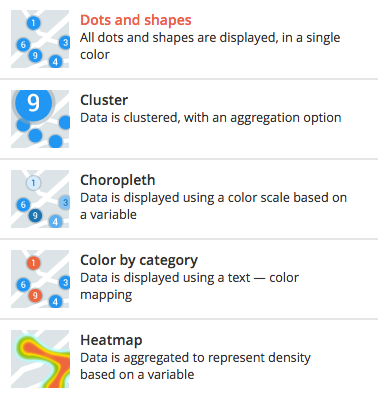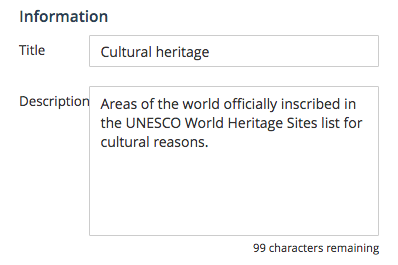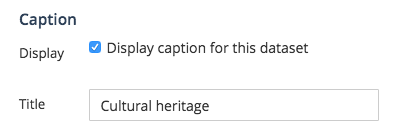Creating multi-layer maps
Add a dataset to your map
Inside the "My maps" interface, in the layer editing area, click on Add a dataset to this map.
Choose the dataset you want to display on your map. You can select a dataset with geographical information either from your own catalog of datasets published on your domain or from the All available data catalog.
Click on Select if you want to add all data or Filter data if you just want to add part of the data.
You can change dataset or change which part is filtered at any time. To do so, simply click on Change filter next to the layer’s title.
You can add as many datasets as you want on your map, and all of the data they contain can be displayed on that same map at the same time. This is when the whole concept of layers comes into play. In the Maps interface, because you overlay several datasets, each dataset is called a layer. This is why Maps allows you to configure your layers to make sure that you can represent many different data on the same map and still make the reading of this map easy and clear.
Keep in mind that the more datasets you add to your map, the heavier it will be and the longer it will take to load.
Edit a layer
Editing a layer (meaning, a dataset displayed on a map created with Maps) has two parts:
Display: the style, in other words, how the data is displayed on the map
Information: the information and caption that go with the dataset in order to better describe it
Edit style
Click on the Display tab. The menu with all style configurations drops down.
Choose a visualization mode and configure your layer as you like.
The style configurations entirely depend on the visualization mode you choose to apply to your layer. There are five different modes:
The style configurations displayed for each visualization mode also depend on your dataset. Depending on the dataset you added to your Maps map, you may not see all the configurations explained in this documentation.
Dots and shapes
The Dots and shapes visualization mode simply displays your data as markers (dots or icons) or as shapes. It is the most common visualization mode.
Style configuration | Description |
Marker display What your data will look like on the map |
If you choose the Icon or the Map marker (with an optional icon) mode:
|
Shape styles Customize your markers and shapes |
For all the options above, simply drag the dot along the slider or directly change the numbers displayed on the right of each slider.
To change the color:
|
Shape borders Customize the border of your markers and shapes |
For the Pattern option, simply click on the provided menu and choose the one you want.
For the options above, simply drag the dot along the slider or directly change the numbers displayed on the right of each line.
To change the color:
|
Cluster
The cluster visualization mode groups your data into clusters instead of displaying them separately and individually. Clusters are grouped according to a chosen type of calculation: linear or logarithmic.
Style configuration | Description |
Cluster style What your cluster will look like on the map |
For all the options above, simply drag the dot along the slider or directly change the numbers displayed on the right of each slider.
To change the color:
|
Cluster border Customize the border of your clusters |
For the options above, simply drag the dot along the slider or directly change the numbers displayed on the right of each slider.
To change the color:
|
Aggregation operations Choose the base operation for your clusters | Choose, out of the available operations, which one you want your clusters to be based on. The result value will be displayed inside the cluster.
|
Computing Choose how the size of the clusters is calculated |
|
Choropleth
The choropleth visualization mode displays data as markers (dots or icons) or as shapes. It also enhances the visualization with colors. The markers and/or shapes are colored according to a color scheme, defined by a values range based on a chosen variable. The Choropleth mode allows the creation of a thematic layer.
Style configuration | Description |
Marker display What your data will look like on the map |
If you choose the Icon or the Map marker (with an optional icon) mode:
|
Shape styles Customize your dots and shapes |
For all the options above, simply drag the dot along the slider or directly change the numbers displayed on the right of each slider.
|
Shape borders Customize the border of your shapes |
For the Pattern option, simply click on the provided menu and choose the one you want.
For the options above, simply drag the dot along the slider or directly change the numbers displayed on the right of each line.
To change the color:
|
Color by category
The Color by category visualization mode displays data as markers (dots or icons) or as shapes. It also enhances the visualization with colors. The markers and/or shapes are colored according to a color scheme based on defined categories - which can be numerical or not, just defined by a certain word. The Color by category mode allows the creation of a categorized layer.
Style configuration | Description |
Marker display What your data will look like on the map |
If you choose the Icon or the Map marker (with an optional icon) mode:
|
Shape styles Customize your dots and shapes |
For all the options above, simply drag the dot along the slider or directly change the numbers displayed on the right of each slider.
In that case, simply choose the right field, and the colors will automatically appear on the corresponding markers and/or dots of your map. |
Shape borders Customize the border of your markers and shapes |
For the Pattern option, simply click on the provided menu and choose the one you want.
For the options above, simply drag the dot along the slider or directly change the numbers displayed on the right of each line.
To change the color:
|
Heatmap
The Heatmap visualization mode is not about markers or shapes. Instead, this mode groups data and displays them as a span of colors to show the differences of intensity of one variable but at different spots in the map.
Style configuration | Description |
Aggregation operations Choose on what operation your heatmap is based. | Choose, out of the available operations depending on your dataset, which one you want your heatmap to be based on.
|
Computing Choose how is calculated the progression of your heatmap |
|
Colors Choose the color palette of your heatmap |
|
Add and edit information
Click the Information tab
Title and description
Rename your layer in the Title area to make it clearer for the map viewers
Add a Description in the provided area
If you do not add your own description, it is the default one that will be displayed.
Icon
You can add an icon to your layer, which will be displayed next to the layer’s title.
Click on the Icon drop-down menu to choose the icon that represents your layer the best
Click on the Color menu to add a color to the layer’s icon
Add and edit a caption
Captions are not mandatory. However, they are recommended because they add more information to your dataset, which means more clarity to the reading of your map.
Click on the Caption tab
If it’s not already the case, tick the Display caption for this dataset option
Captions are activated by default. If you do not want to display a caption for your dataset, simply untick the Display caption for this dataset option.
In the provided area, write a Title for your layer’s caption
Delete a layer
Click on the delete icon
Click on the red Remove dataset from the map button








